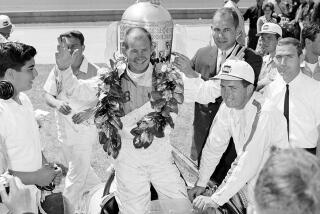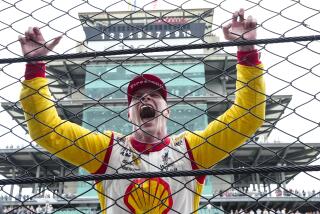Western 500 : Riverside Win Would Put a Perfect Cap on Earnhardt’s Title Year
- Share via
RIVERSIDE — Richard Childress drove in 285 Winston Cup races between 1969 and 1981 and didn’t win a single one. He rarely finished among the top five.
On Aug. 2, 1981, he dropped out of the Talladega 500 with a broken engine and has not driven a race car since.
Childress turned from race car driver to race car owner and team manager that day. He hired Dale Earnhardt, the reigning Grand National champion who was inexplicably without a ride, to drive for him.
Today, as the 1986 season comes to a close with the Winston Western 500 at Riverside International Raceway, Childress has his first NASCAR championship with Earnhardt as his driver.
Earnhardt, driving Childress’ yellow-and-blue No. 3 Chevrolet Monte Carlo, took care of that two weeks ago when he won the Atlanta Journal 500 to stretch his lead over defending champion Darrell Waltrip to an insurmountable 278 points.
“I have to give Richard Childress all the credit,” Earnhardt said. “He does all the planning and preparation of the race team. I drive whatever he has ready for me and know it’s the best possible car he can put on the track. That’s a wonderful feeling for a driver.”
Earnhardt has won five races and $1,141,350 this year--not counting the $550,000 he will receive at the NASCAR banquet as the new champion.
“The perfect cap on the year would be to win the Riverside race,” Earnhardt said after qualifying eighth at 115.941 m.p.h.
The two drivers who challenged him for the championship most of the season, Tim Richmond and Waltrip, will be on the front row when the 500-kilometer (311-mile) race for American-built stock cars starts at 11 a.m.
Richmond won the pole with a record 118.247-m.p.h. lap.
“I don’t have to worry about saving the car to finish for points so I can be a lot more aggressive,” Earnhardt said. “Riverside is a little off-beat for us, but I enjoy the challenge of the road course itself. I’ve never won here.” Earnhardt finished second in the 1981 Warner Hodgdon 400, losing by a car length to Waltrip.
“There’s another reason I want to win. Hollywood (Richmond) has won six races, and I’ve won five. I want to get even with him.”
Childress built a road course-only car this year, the first time the team has had such a luxury. Earnhardt finished fourth here last June and third at Watkins Glen in August. “I’ve got to finish second or win,” Earnhardt said. “It’s the natural progression for the car Richard built for me.”
Life has not always been so upbeat for the two Good Ol’ Boys from North Carolina. Dale, 34, is from Mooresville, a dot on the map near Charlotte, and Richard, 41, is from Winston-Salem.
Earnhardt was a brash charger still wet behind the ears--Grand National racing-wise--when he edged Cale Yarborough to win his first championship at Ontario in 1980. It was only his second year on the circuit, the least experienced champion in history.
The win turned sour the following year when his car owner, Rod Osterlund of San Jose, abruptly sold the team in the middle of the season.
“I had some good offers from other teams after I won the championship, but Osterlund told me in December that we’d be together for five years. I believed him.
“I was hurt when he didn’t show up for the NASCAR banquet. Maybe I should have been suspicious after that. All the guys on the team were there, and the leader didn’t show up. That was disheartening.
“Then one day I get a call and find out the team has been sold to J. D. Stacy. When Stacy told me he didn’t care if I drove for him or not, that hurt, too. I was the national champion, and the guy who owns my contract says he doesn’t care. I didn’t want to drive for someone who didn’t want me.”
After two races, Earnhardt quit Stacy, taking his helmet and his Wrangler sponsorship to Childress.
“Sometimes opportunity only knocks once, so when I had a chance to get the reigning champion to drive my car, I didn’t hesitate,” Childress said. “I couldn’t see any future in the way I was going (as a driver).” Childress never won a race but it was during those frustrating 12 years he worked on his under-financed car in a tiny shop in Winston-Salem that he prepared himself for running a team when the opportunity knocked.
In 1979 he told a reporter visiting his garage: “I don’t expect to win a race because I can’t run hard and try to beat Yarborough or Petty or Allison. I might beat them but I can’t take the chance with my car. If my car breaks, I might not have enough money to have it fixed for the next race. I run to finish. That way I pile up points and hope to be in the Top 10 at the end of the year. That’s all I can hope for.”
In those days, Childress did everything on the car except jump out during pit stops and change his own tires.
With Earnhardt, he got not only an aggressive driver but also financial backing brought along by the champion.
“We ran 10 or 11 races together the rest of ’81 and got along fine,” Earnhardt recalled. “Richard showed he could operate a race team and attracted some sponsors, but he was not ready for us to stay with him, so Wrangler and I joined Bud Moore’s team for 1982.”
Earnhardt drove a Ford for two years while Ricky Rudd drove for Childress.
“Richard and I stayed in touch during that time, and when I began to get sour of Ford in ‘83, I told my sponsor that I was going to make a change. They said they’d come with me and I called Richard. I had some offers for a lot more money but I felt we could build a winning team together. This year proved I was right.”
Moore and Childress pulled a baseball-like trade, Rudd moving to Moore’s team in a swap when Earnhardt joined Childress.
“It was one of the hardest things I ever did, telling Bud (Moore) I was leaving,” Earnhardt said. “He was a good friend of my daddy, and Bud did an awful lot for me in those two years. He treated me like a son.”
Earnhardt’s father, Ralph, won NASCAR’s late model sportsman championship in 1956. That same year he won 11 track championships from Pennsylvania to Florida to Tennessee.
“People ask me if I learned to drive from my daddy,” Earnhardt said. “I must have. From the time I could walk I tagged around after him. I watched him in hundreds of races. Something must have rubbed off on me.”
Ralph Earnhardt died at home of a heart attack in 1973 at age 45. The year previous he had won the track titles at the Charlotte Fairgrounds and Concord (N.C.) Speedway.
The Childress-Earnhardt team labored for two seasons before all the ingredients for a championship were in place.
“In ’85 we had engine problems in 11 races,” Earnhardt explained. “Richard went home over the winter and worked that out himself. He just goes at everything 100 percent.”
This year did not start out all that well, either.
Earnhardt dominated Speed Weeks at Daytona, winning the Busch Clash, a 125-mile qualifier and a Saturday Grand National race in a car that his wife, Teresa, owns. In the 500, he was dogging Geoff Bodine in the late stages of the race when his car ran out of gas.
The next race was at Richmond, and Earnhardt and Waltrip got into a fender-banging episode that led to Earnhardt being $5,000 fine and placed on probation for the rest of the season for “reckless driving.” Childress appealed and the suspension was lifted and the fine reduced to $3,000, but the stigma followed Earnhardt.
Earnhardt started moving up the championship ladder when he won back-to-back races at Darlington and North Wilkesboro in April. He won again at Charlotte in May but ran into a drought while Richmond and Waltrip mounted challenges. When the NASCAR trail came to Charlotte for a second time last month, Earnhardt won again.
“That win at Charlotte in October gave us a good feeling about winning the championship,” he said. “We were down to the final four races and winning there gave us the confidence to pull it off.”
More to Read
Go beyond the scoreboard
Get the latest on L.A.'s teams in the daily Sports Report newsletter.
You may occasionally receive promotional content from the Los Angeles Times.










